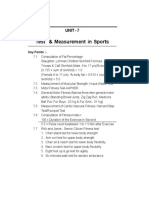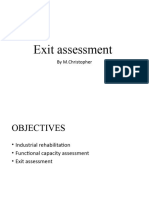0 ratings0% found this document useful (0 votes)
1K viewsHarward Step Test
Harward Step Test
Uploaded by
Pradeep PatilThe Harvard step test is a cardiovascular fitness test that measures aerobic endurance. Participants step up and down on a bench for 5 minutes at a rate of 30 steps per minute. Their heart rate is measured 1-1.5 minutes after completion to calculate a fitness index score, with higher scores indicating better cardiovascular fitness. The test requires minimal, inexpensive equipment but results can be impacted by individual biomechanical differences.
Copyright:
© All Rights Reserved
Available Formats
Download as PPT, PDF, TXT or read online from Scribd
Harward Step Test
Harward Step Test
Uploaded by
Pradeep Patil0 ratings0% found this document useful (0 votes)
1K views12 pagesThe Harvard step test is a cardiovascular fitness test that measures aerobic endurance. Participants step up and down on a bench for 5 minutes at a rate of 30 steps per minute. Their heart rate is measured 1-1.5 minutes after completion to calculate a fitness index score, with higher scores indicating better cardiovascular fitness. The test requires minimal, inexpensive equipment but results can be impacted by individual biomechanical differences.
Copyright
© © All Rights Reserved
Available Formats
PPT, PDF, TXT or read online from Scribd
Share this document
Did you find this document useful?
Is this content inappropriate?
The Harvard step test is a cardiovascular fitness test that measures aerobic endurance. Participants step up and down on a bench for 5 minutes at a rate of 30 steps per minute. Their heart rate is measured 1-1.5 minutes after completion to calculate a fitness index score, with higher scores indicating better cardiovascular fitness. The test requires minimal, inexpensive equipment but results can be impacted by individual biomechanical differences.
Copyright:
© All Rights Reserved
Available Formats
Download as PPT, PDF, TXT or read online from Scribd
Download as ppt, pdf, or txt
0 ratings0% found this document useful (0 votes)
1K views12 pagesHarward Step Test
Harward Step Test
Uploaded by
Pradeep PatilThe Harvard step test is a cardiovascular fitness test that measures aerobic endurance. Participants step up and down on a bench for 5 minutes at a rate of 30 steps per minute. Their heart rate is measured 1-1.5 minutes after completion to calculate a fitness index score, with higher scores indicating better cardiovascular fitness. The test requires minimal, inexpensive equipment but results can be impacted by individual biomechanical differences.
Copyright:
© All Rights Reserved
Available Formats
Download as PPT, PDF, TXT or read online from Scribd
Download as ppt, pdf, or txt
You are on page 1of 12
Harvard Step Test
Harvard Step test
Brouha (1943) Constructed test for
measuring Cardiovascular endurance of
human beings by using easily available
& inexpensive equipment. The test was
developed on 220 college men by
administering it simultaneously on small
groups of students.
Harvard Step Test
The Harvard step test is a cardio vascular
fitness test. It is also called aerobic
fitness test. It is used to measure the
cardio vascular fitness or aerobic fitness
by checking the recovery rate.
Equipment required: A gym bench or box
of 20 inches high for man and 16 inches
for woman stopwatch and cadence tape.
Harvard Step test
Test administration
Procedure: The athlete warms up for 10
minutes.
The athlete stands in the front of the bench
or box.
On the command “GO” the athlete steps
up and down on the bench or box at a rate
of 30 steps per minute.
Stopwatch is also started at the start of the
stepping.
Procedure
procedure:
The subject steps up and down on the platform at a rate of 30
steps per minute (every two seconds) for 5 minutes. The subject
immediately sits down on completion of the test, and the total
number of heart beats are counted between 1 to 1.5 minutes after
finishing (see measuring heart rate). This is the only measure
required if using the short form of the test.
If the long form of the test is being conducted, there is an
additional heart rate measures at between 2 to 2.5 minutes, and
between 3 to 3.5 minutes.
Scoring:
scoring: the Fitness Index score is determined by the
following equations. For example, if the total test time
was 300 seconds (if completed the whole 5 minutes),
and the number of heart beats between 1-1.5 minutes
was 90, between 2-2.5 it was 80 and between 3-3.5 it
was 70, then the long form Fitness Index score would
be:
(100 x 300) / (240 x 2) = 62.5. Note: you are using the
total number of heart beats in the 30 second period,
not the rate (beats per minute) during that time.
Fitness Index
Fitness Index (short form) = (100 x test
duration in seconds) divided by (5.5 x
pulse count between 1 and 1.5
minutes).
Fitness Index (long form) = (100 x test
duration in seconds) divided by (2 x sum
of heart beats in the recovery periods).
Advantages & disadvantages
ADVANTAGES: This test requires minimal equipment
and costs, and can be self-administered.
DISADVANTAGES: Biomechanical characteristics
vary between individuals. For example, considering
that the step height is standard, taller people are at an
advantage as it will take less energy to step up onto
the step. Body weight has also been shown to be a
factor. Testing large groups with this test will be time
consuming.
Scoring:
However, in case the subject is unable to do
the step exercise for full five minutes, Brouha
had recommended a direct scoring scheme
given below, which was irrespective of the
after exercise pulse counts:
Scoring:
Duration of Exercise Score
Less than 2 minutes 25
From 2.00 to 3.00 minutes 38
From 3.01 to 3.50 minutes 48
From 3.51 to 4.00 minutes 52
From 4.01 to 4.50 minutes 55
More than 4.50 minutes 59
Heart
You might also like
- Yoga and LifestyleDocument13 pagesYoga and Lifestylelohota100% (2)
- Fundamentals of Plant Physiology Lincoln Taiz Ian Annas ArchiveDocument646 pagesFundamentals of Plant Physiology Lincoln Taiz Ian Annas ArchiveTiago Oliveira100% (6)
- MargaiaStairClimbTest PDFDocument2 pagesMargaiaStairClimbTest PDFMohd Afiq100% (1)
- BiomechanicsDocument46 pagesBiomechanicsGiriprasath.D100% (1)
- Characteristics of Sports TrainingDocument6 pagesCharacteristics of Sports TrainingPradeep Patil100% (2)
- Karapatan NG Batang Pilipino-RevisedDocument1 pageKarapatan NG Batang Pilipino-RevisedArl Pasol100% (1)
- Harward Step TestDocument12 pagesHarward Step TestPradeep PatilNo ratings yet
- Test and Measurement in Sports: Motor Fitness Test-AAHPERDocument5 pagesTest and Measurement in Sports: Motor Fitness Test-AAHPERVisakh A SNo ratings yet
- Physical Education Class 12 Study Material Chapter 7Document23 pagesPhysical Education Class 12 Study Material Chapter 7Aaditya Mittal0% (1)
- PE 12 Chapter 7Document19 pagesPE 12 Chapter 7K SahinandanNo ratings yet
- Physical Education For Written in Lab ManualDocument24 pagesPhysical Education For Written in Lab ManualAnirudh Pratap0% (1)
- General Motor FitnessDocument25 pagesGeneral Motor FitnessSahil ChauhanNo ratings yet
- Chapter-10 (Training in Sports)Document12 pagesChapter-10 (Training in Sports)Om Kumar SinghNo ratings yet
- CH-6 C - Test and Measurement in SportsDocument13 pagesCH-6 C - Test and Measurement in SportsAkankshaNo ratings yet
- Topic - The Lockhart-Mcpherson Badminton Test: Assignment of Measurement and Evaluation in Physical EducationDocument3 pagesTopic - The Lockhart-Mcpherson Badminton Test: Assignment of Measurement and Evaluation in Physical EducationAayush SaxenaNo ratings yet
- Chapter 12 Linear Kinetics NotesDocument76 pagesChapter 12 Linear Kinetics NotesJason EdwardsNo ratings yet
- Hockey TestsDocument35 pagesHockey Tests546 Aman Singh TomarNo ratings yet
- 12 Physical Education Chapter 7Document25 pages12 Physical Education Chapter 7Shardul Vikram SinghNo ratings yet
- Physical Education Project Soumyajit SahaDocument12 pagesPhysical Education Project Soumyajit SahaRitam SadhukanNo ratings yet
- Tennis ProjectDocument4 pagesTennis ProjectIndescifrable thoughts100% (1)
- Construction of 400m TrackDocument62 pagesConstruction of 400m Trackmurnirah8478% (23)
- Unit 3 Yoga and Life Style 2022-23newDocument16 pagesUnit 3 Yoga and Life Style 2022-23newxxjksvddukebNo ratings yet
- JCR TestDocument8 pagesJCR TestDeepu HazarikaNo ratings yet
- Project File HockeyDocument12 pagesProject File HockeyRajat singhalNo ratings yet
- Khokho RulesDocument18 pagesKhokho Rulesapi-29656111680% (5)
- Children & Women in Sports NotesDocument11 pagesChildren & Women in Sports NotesDushyant Singh Jadon100% (1)
- Rogers Physical Fitness IndexDocument17 pagesRogers Physical Fitness IndexDeepu Hazarika0% (1)
- Principles of Aerobic ExerciseDocument23 pagesPrinciples of Aerobic ExerciseAmina Sawalmeh100% (3)
- Biomechanics and Sports (Lecture Notes)Document6 pagesBiomechanics and Sports (Lecture Notes)Corteza, Ricardo Danilo E. Unknown0% (1)
- The Queens College Step TestDocument12 pagesThe Queens College Step TestYousra ShaikhNo ratings yet
- Khelo India Test 2023Document12 pagesKhelo India Test 2023asi795856No ratings yet
- UNIT - 6: Test & Measurement in Sports..!! Along-With Important QuestionsDocument68 pagesUNIT - 6: Test & Measurement in Sports..!! Along-With Important QuestionsMahima Famous100% (1)
- Class 12 Practical File 2023Document30 pagesClass 12 Practical File 2023Mannat EducationNo ratings yet
- 12 Physical Education CH 10 Kinesiology Biomechanics SportsDocument6 pages12 Physical Education CH 10 Kinesiology Biomechanics SportsHritik RajNo ratings yet
- XI - UNIT-10 Training and Doping in SportsDocument58 pagesXI - UNIT-10 Training and Doping in Sportspriya2kalyanNo ratings yet
- 12 Physical Education CH 3 Yoga Lifestyle PDFDocument8 pages12 Physical Education CH 3 Yoga Lifestyle PDFSaumyaNo ratings yet
- Gymnastic - by SlidesgoDocument21 pagesGymnastic - by Slidesgoapril joy manzanillaNo ratings yet
- 3-Yoga As Preventive Measures For Lifestyle DiseasesDocument22 pages3-Yoga As Preventive Measures For Lifestyle DiseasesDivyanshu Yadav100% (1)
- Physical Education: Project ReportDocument11 pagesPhysical Education: Project ReportAvnish Bhasin100% (1)
- Comparative Study On Johnson Soccer Test Scores of Soccer PlayersDocument3 pagesComparative Study On Johnson Soccer Test Scores of Soccer Playersfahmie halimNo ratings yet
- PT As Patient Client ManagerDocument39 pagesPT As Patient Client Managerpihabo3594No ratings yet
- Surya NamaskarDocument6 pagesSurya NamaskarKrm ChariNo ratings yet
- 12 Physical Education Chapter 3Document24 pages12 Physical Education Chapter 3akanksha nayan100% (1)
- MC Donald Test (Sports Gyan)Document1 pageMC Donald Test (Sports Gyan)Mir Rehan Mushtaq0% (2)
- Exit Assessment 1Document49 pagesExit Assessment 1jayadevanNo ratings yet
- ch-2 Sports and Nutrition PDFDocument10 pagesch-2 Sports and Nutrition PDFSatyajeet ChauhanNo ratings yet
- Class 12 Physical Education Revision Notes For Sports and Nutrition of Chapter 2Document14 pagesClass 12 Physical Education Revision Notes For Sports and Nutrition of Chapter 2yatishkewalramani123No ratings yet
- AthleticsDocument17 pagesAthleticsIshita BhatiaNo ratings yet
- 12 Physical Education CH 12 Training in SportsDocument8 pages12 Physical Education CH 12 Training in SportsKunal GargNo ratings yet
- Bruce ProtocolDocument13 pagesBruce ProtocolDevilsnareNo ratings yet
- HCPR - IWDGF Foot Risk ClassificationDocument2 pagesHCPR - IWDGF Foot Risk ClassificationEva Arna Abrar100% (1)
- Unit II. Children & Women in Sports - Class-12Document7 pagesUnit II. Children & Women in Sports - Class-12hhh klpNo ratings yet
- DefinitionsDocument4 pagesDefinitionsKarthikeyan Guru67% (3)
- 12 Physical Education CH 07 Test and Measurement Ins SportsDocument19 pages12 Physical Education CH 07 Test and Measurement Ins SportsHritik RajNo ratings yet
- Bruce and Naughton ProtocolDocument13 pagesBruce and Naughton ProtocolDheeraj RaiNo ratings yet
- Angle or Pull of MuscleDocument13 pagesAngle or Pull of MuscleSneh KevadiyaNo ratings yet
- Aahpered TestDocument7 pagesAahpered TestSachin pandaNo ratings yet
- SodapdfDocument3 pagesSodapdfKenichi KNo ratings yet
- Cardiorespiratory FitnessDocument44 pagesCardiorespiratory FitnesssuperallNo ratings yet
- Harvard Step TestDocument4 pagesHarvard Step TestKiran ShahidNo ratings yet
- Chaptre 5Document56 pagesChaptre 5Moi WakshumaNo ratings yet
- Step TestDocument16 pagesStep Test4kfzzagyveNo ratings yet
- BCS KardiovaskulerDocument37 pagesBCS KardiovaskulerhragunathanNo ratings yet
- McDonald Soccer Skill TestDocument4 pagesMcDonald Soccer Skill TestPradeep Patil100% (1)
- SAI Basketball Skill TestDocument2 pagesSAI Basketball Skill TestPradeep Patil83% (6)
- Kabaddi BookDocument69 pagesKabaddi BookPradeep PatilNo ratings yet
- Kabaddi BookDocument69 pagesKabaddi BookPradeep PatilNo ratings yet
- Factors Determining FlexibilityDocument2 pagesFactors Determining FlexibilityPradeep PatilNo ratings yet
- Painting by Spraying: Offshore Coshh EssentialsDocument4 pagesPainting by Spraying: Offshore Coshh EssentialsCorrosion FactoryNo ratings yet
- Soal Pas Bing 9 PDFDocument9 pagesSoal Pas Bing 9 PDFSyva Aisha Luvena AANo ratings yet
- Bauknecht TK Care 17bDocument19 pagesBauknecht TK Care 17bcrisbo88No ratings yet
- How To Get Yourself To Do ThingsDocument5 pagesHow To Get Yourself To Do ThingsRobin Perkins100% (1)
- Sarnafast® KTL: Product Data SheetDocument3 pagesSarnafast® KTL: Product Data SheetRoyete M Silfani PattyNo ratings yet
- Mantra Harry PotterDocument5 pagesMantra Harry PotterAndry MaulanaNo ratings yet
- U.F. SP210.N 23 10 Web VersionDocument32 pagesU.F. SP210.N 23 10 Web Versionmehdi HKNo ratings yet
- Abra High School Subject: Disaster Risk Reduction Bangued, Abra Quarter: 3Document6 pagesAbra High School Subject: Disaster Risk Reduction Bangued, Abra Quarter: 3Erwin AllijohNo ratings yet
- Determining The Production and Transport Cost ForDocument24 pagesDetermining The Production and Transport Cost ForClara SanchezNo ratings yet
- Evidence BasedDocument4 pagesEvidence BasedRitu yousufNo ratings yet
- Household and Structural Pest Management For ProfessionalsDocument25 pagesHousehold and Structural Pest Management For ProfessionalsCyrusianNo ratings yet
- 7 Bond and Development Length-SlightDocument47 pages7 Bond and Development Length-Slightريام الموسويNo ratings yet
- Highly Sensitive and Selective Gas Sensors Using P-Type Oxide Semiconductors - OverviewDocument21 pagesHighly Sensitive and Selective Gas Sensors Using P-Type Oxide Semiconductors - OverviewPopescu AndreeaNo ratings yet
- Ms DD 4810 Ics DWG 0302 - Rev2Document1 pageMs DD 4810 Ics DWG 0302 - Rev2lhecemponNo ratings yet
- Processcard 103 (PAC)Document2 pagesProcesscard 103 (PAC)Pablo Leon RoblesNo ratings yet
- Vulcanization: Dr. Muhammad FarooqDocument28 pagesVulcanization: Dr. Muhammad FarooqRana AnasNo ratings yet
- STEM Scopes - Food ChainsDocument3 pagesSTEM Scopes - Food Chains4228276No ratings yet
- Design of Footing For Corner ColumnDocument4 pagesDesign of Footing For Corner ColumnMegatech Engineering ConsultantsNo ratings yet
- Exercise For Subject and Verb AgreementDocument4 pagesExercise For Subject and Verb AgreementLÂM100% (1)
- Relational Patterns, Therapeutic Presence: Concepts and Practice of Integrative Psychotherapy by Richard G. ErskineDocument7 pagesRelational Patterns, Therapeutic Presence: Concepts and Practice of Integrative Psychotherapy by Richard G. ErskineCCIBRN RUSIANo ratings yet
- Climate Change and GroundwaterDocument187 pagesClimate Change and GroundwaterRani FouadNo ratings yet
- CelQuant 3i - Service ManualDocument18 pagesCelQuant 3i - Service ManualKeigo ChewNo ratings yet
- 1996 Swimming Pool DesignDocument58 pages1996 Swimming Pool DesignMehdi NasriNo ratings yet
- FACE 2 Years Advanced Orthodontics ProgramDocument9 pagesFACE 2 Years Advanced Orthodontics ProgramFace-Course RomaniaNo ratings yet
- BIOA01 3 Lecture 2Document4 pagesBIOA01 3 Lecture 2krittikaNo ratings yet
- Insect Control in TobaccoDocument10 pagesInsect Control in Tobaccozahid mehmoodNo ratings yet
- Biochemistry TA Notes Part 1Document49 pagesBiochemistry TA Notes Part 1lovelyc95No ratings yet
- I50 Portable BW Digital Ultrasound Machine ZoncareDocument2 pagesI50 Portable BW Digital Ultrasound Machine ZoncareFrezer MengistuNo ratings yet































































































